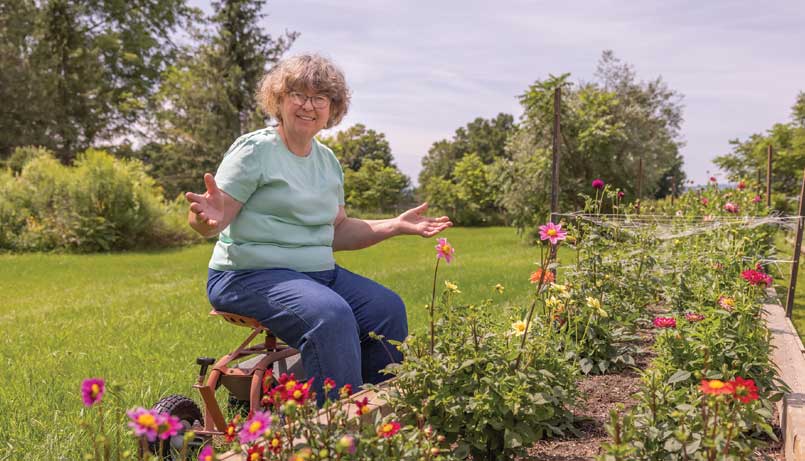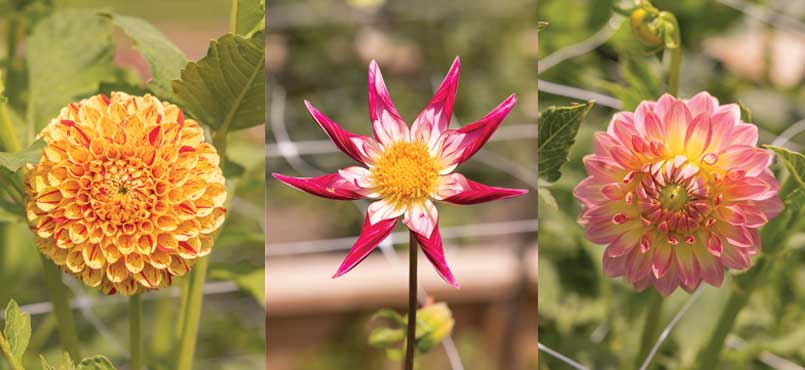
Marian Jean, a long-time cultivator and founder of Oakridge Dahlias

Right to left: Hollyhill Spreckles, RaeAnn’s Alcor, Oreti Adele
Naming a new variety of dahlia takes skill and patience – and a nod from the American Dahlia Society
Café au Lait, AC White Rabbit, Felida Freckles, Western Spanish Dancer, Verrone’s Taylor Swift and Blithe Spirit – the names are as colourful and diverse as the dahlias they represent. At this time of year, when cultivators are exhibiting their best blooms at fall fairs and new varieties adorn the pages of flower catalogues, you may wonder about the circumstances and people who inspired those names. Or maybe you have asked yourself who actually has the power to bestow dahlia flower names.
Marian Jean, a long-time cultivator and founder of Oakridge Dahlias, has the answer. She has been growing over 500 varieties of the flower on her sprawling property at the edge of the Oak Ridges Moraine for more than ten years.
THE NAMING OF DAHLIAS
“There are a few ways that a person can officially name a new variety of dahlia,” she answers. One way is to submit your tubers plus a fee of twelve dollars to three sanctioned ADS “trial gardens” and receive a passing grade. Another popular pathway is for your flower to receive high scores from three judges at a few sanctioned flower shows that have a “seedling bench.”
The ADS, or American Dahlia Society, is the official organization that evaluates and catalogues dahlias in North America and publishes the authoritative Classification and Handbook of Dahlias. The non-profit organization represents more than seventy local societies across the US and Canada and has helped introduce dozens of new hybrids to the floral community since its founding in 1915.
Marian has decided to undergo the evaluation process herself so that she can name a brilliant yellow, open-faced dahlia in honour of her late mother-in-law.
“We lost Suzanne to COVID,” she recalls. “During that time, I was out in the seedling patch and this flower caught my eye because of its unusually vibrant yellow colour. It has strong petals, a perfect round centre, and it immediately reminded me of her bright, outgoing personality. It seemed like a fitting tribute to name it after her.”
And that was how the Oakridge Suzanne was born.
DAHLIAS: A GARDEN STAPLE
Marian’s decade-long love of dahlias actually began because of a name.
“I was searching for a gift for my mother’s birthday, and was looking at varieties of dahlias online,” she remembers. “I stumbled upon a dahlia that shared my mom’s name – Jessie G. The grower was in Nova Scotia so I decided to make it worth my while, and instead of buying the one, I ended up buying 30 varieties!”
Many growers of dahlias will tell you similar stories of how their obsession for this equatorial flower began. Dahlias have always been a garden staple because they are relatively easy to grow, either from seed or from tuberous roots. Equally attractive is their diversity: With forty-two species of the flower to choose from and an infinite number of hybrid varieties (like the colourful, round Ball variety, or the towering firecracker-like blooms of a Cactus variety, or the multi-hued Waterlily and Collarette varieties), it’s easy to get carried away.
Dahlias are also great propagators. Marian can sometimes harvest as many as six new tubers from a single plant, and she regularly ships close to 2,500 tubers per season to avid dahlia growers.
THE NAMING OF DAHLIAS
“Dahlias were not always this popular,” she recalls. “They used to be the flower that our grandparents grew. My mother considered them old-fashioned. Then luckily for me, just after I got into them, the Café Au Lait dahlia was named best flower for your wedding bouquet, and the flower’s popularity went through the roof.”
Marian is referring to celebrity lifestyle magazine publisher Martha Stewart’s famous 2014 endorsement of the blush-coloured dahlia, which inspired brides to request it for their bouquets.
Having studied biology in university, Marian offers a more scientific reason the dahlia is so highly regarded by hybridizers.
“Dahlias are octoploids – they have eight sets of homologous chromosomes, whereas most things, including humans, only have two,” she says.
She further explains that these extra chromosomes, coupled with transposons (or mobile genetic material) allow the plant to alter its genetic makeup.
These elements also mean that you are unlikely to ever grow exactly the same variety of dahlia twice. The only way to replicate the same plant is by dividing the original tuber, or by rooting cuttings.
And here is where the naming of new hybrids gets tricky. For the flower to be classified, it has to be “stable” – meaning that it has to reproduce itself in the same form, size and colour over three consecutive years.
INTRODUCING A NEW FLOWER
Oakridge Suzanne is a hybrid from an open-pollinated Collarette variety called Hy Winefrost, from Wayne Holland of Hy Dahlias. The original flower is purple hued with a bright orange centre, while Marian’s hybrid produces bright yellow single flowers, with a round vivid orange-gold-coloured centre.
Marian meticulously divided the tubers from the plants for three seasons, tucking them away in her climate-controlled basement for the winter and replanting them each spring. She is now ready to submit her new hybrid for evaluation. Three tubers from the current plants will be sent to each of three trial gardens, two in the US and one in Red Deer County, Alberta – the only ADS approved location in Canada.
Trial gardens are generally located in parks or areas where the public can visit and watch the flowers grow and bloom. The ADS provides detailed specifications for the practices used to grow the dahlias as well as for their evaluation. After Marian sends off her tubers, the decision is out of her hands and the waiting game begins.
“Dahlias were not always this popular. They used to be the flower that our grandparents grew. My mother considered them old-fashioned.” MARIAN JEAN
If she is successful and her tubers receive a high enough score, Oakridge Suzanne will be listed in the Classification and Handbook of Dahlias and Marian can make the flower available commercially. She will also be among only a handful of cultivators in Canada to have named a new dahlia.
“That would be a celebration for sure and especially meaningful for our family,” she says.
To have a dahlia cultivator who has grown – and will soon hopefully name – a new flower in the Watershed region is inspiring to local gardeners. After all, who wouldn’t love to have their name on a colourful piece of floral history?
Story by:
Micol Marotti
Photography by:
Alana Lee




